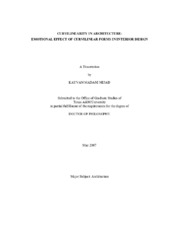| dc.description.abstract | People are becoming more aware of the relationships between the built
environment and their physical and psychological well-being. This has encouraged
numerous studies in the field of environment and behavior, and effects of architecture,
urban design and architectural form on human response. In the realm of architectural
form, some professionals, from "signature" architects to environmental and organic
designers, are strong advocates of free-flowing curvilinear forms. They assume that the
use of curvilinear forms is sympathetic to the body, mind and spirit, although there is
little empirical research to confirm this claim. There is also little research on the topic of
signature / star architects and their design methods.
The purpose of this multi-method study was to investigate the emotional effects
of curvilinear forms in interior architectural settings. The research involved qualitative
and quantitative methodologies. In the qualitative phase, twelve signature architects,
known for their use of curvilinear forms, were interviewed to examine the reasons and
processes by which they applied curvature in their work. They were also asked to talk
about their design process. In the quantitative phase, two modified interior residential
views were ranked on their emotional load by 230 non-architect and 75 architect students in card-sorting tasks. In each view, architectural forms gradually changed from
fully rectilinear to fully curvilinear.
The data from both phases of the research was analyzed. The dissertation
concludes by discussing (a) factors that separate signature architects from others (b) how
signature architects design (c) how and why designers utilize curvature in the built
environment, and (d) different emotional responses of designers and non-designers in
response to curvature in architectural settings. In general, quantitative data indicates that
non-architects show significant positive response to curvilinear architectural forms. Nonarchitects
found curvilinear forms to be pleasant, elevating and reducing stress. The
strongest relationship was recorded between curvature and feminine qualities of
architectural space, which was shared by both architects and non-architects. | en |


